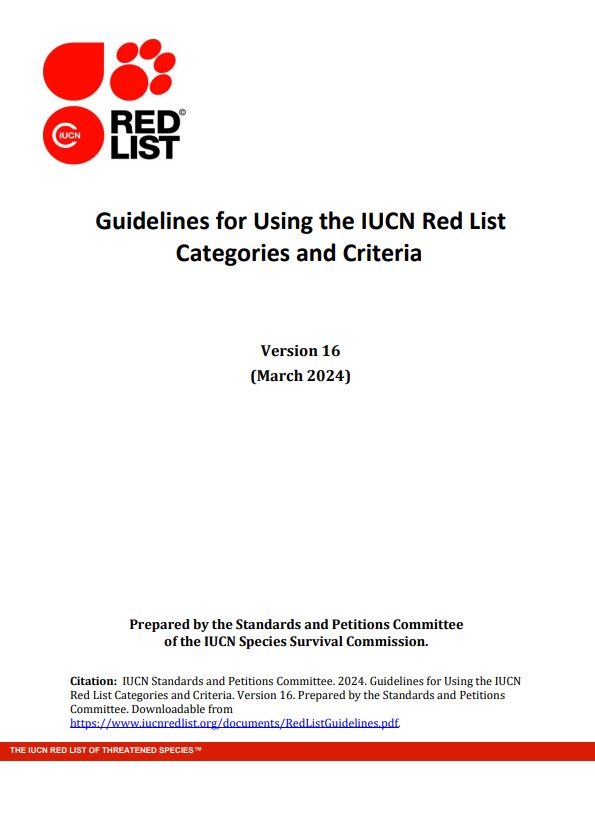
목차
1. Introduction 5
2. An Outline of the Red List Categories and Criteria 5
2.1 Taxonomic level and scope of the categorization process 5
2.1.1 Taxonomic scale of categorization 5
2.1.2 Geographical scale of categorization 7
2.1.3 Introduced taxa and subpopulations 8
2.1.4 Managed subpopulations 9
2.2 Nature of the categories 9
2.2.1 Transfer between categories 12
2.3 Nature of the criteria 15
2.3.1 The quantitative thresholds 17
2.4 Conservation priorities and actions 19
2.5 Documentation 19
3. Data Quality 20
3.1 Data availability, inference, suspicion, and projection 20
3.2 Uncertainty 23
3.2.1 Types of uncertainty 23
3.2.2 Representing uncertainty 24
3.2.3 Dispute tolerance and risk tolerance 24
3.2.4 Dealing with uncertainty 25
3.2.5 Documenting uncertainty and interpreting listings 25
3.2.6 Uncertainty and the application of the categories Data Deficient and Near Threatened 25
4. Definitions of Terms Used in the Criteria and their Calculation 25
4.1 Population and population size (criteria A, C and D) 26
4.2 Subpopulations (criteria B and C) 26
4.3 Mature individuals (criteria A, B, C and D) 26
4.3.1 Notes on defining mature individuals 27
4.3.2 Clonal colonial organisms 28
4.3.3 Fishes 29
4.3.4 Sex-changing organisms 29
4.3.5 Trees 30
4.4 Generation (criteria A, C1 and E) 30
4.5 Reduction (criterion A) 33
4.5.1 Calculating population reduction using statistical methods 33
Exponential decline 34
Linear decline 36
Accelerated decline 36
Complex patterns of decline 37
4.5.2 Calculating population reduction using population models 38
4.5.3 Taxa with widely distributed or multiple subpopulations 38
4.5.4 Estimating overall reduction 39
Example 1: Estimates are available for past (three generations ago) and current population sizes. 39
Example 2: Estimates are available for various past population sizes. 40
Example 3: Estimates are available for various past population sizes for some subpopulations only. 41
Example 4: Multiple estimates are available for various past population sizes. 41
4.5.5 Dealing with uncertainty 42
Using uncertain estimates 42
Using data with different units 43
Using data from a few subpopulations 44
4.5.6 Fluctuations vs. reduction 44
4.6 Continuing decline (criteria B and C) 45
4.7 Extreme fluctuations (criteria B and C2) 46
4.8 Severely fragmented (criterion B) 49
4.9 Extent of occurrence (criteria A and B) 51
4.10 Area of occupancy (criteria A, B and D) 54
4.10.1 Problems of scale 55
4.10.2 Methods for estimating AOO 55
4.10.3 The appropriate scale 56
4.10.4 Scale-area relationships 56
4.10.5 Scale correction factors 57
Example: Scaling Up 57
Example: Scaling Down 58
4.10.6 "Linear" habitat 59
4.10.7 AOO and EOO based on habitat maps and models 60
4.10.8 Effect of sampling effort and detectability on estimates of AOO 61
4.10.9 Complementarity of AOO, EOO and number of locations 62
4.11 Location (criteria B and D) 63
4.12 Quantitative analysis (criterion E) 64
5. Guidelines for Applying Criterion A 64
5.1 The basis of reductions 66
5.2 The use of time caps in criterion A 68
5.3 How to apply criterion A4 68
5.4 Reduction followed by short-term stabilization or increase: The 'ski-jump' effect 69
5.5 Historical reduction followed by long-term stabilization: Severely depleted populations 69
5.6 Fisheries 70
5.6.1 Fisheries management and extinction risk 70
5.6.2 Technical aspects of using criterion A for fisheries 71
5.7 Long-lived taxa 71
5.8 Relationship between loss of habitat and population reduction 71
6. Guidelines for Applying Criterion B 72
7. Guidelines for Applying Criterion C 73
8. Guidelines for Applying Criterion D 74
8.1 Taxa known only from the type locality 75
8.2 Example of applying criterion D 75
8.3 Example of applying criterion D2 75
9. Guidelines for Applying Criterion E 75
9.1 What is extinction? 76
9.2 Which method can be used? 76
9.3 Are there sufficient data? 77
9.4 Model components and parameters 78
9.4.1 Density dependence 78
9.4.2 Temporal variability 78
9.4.3 Spatial variability 79
9.5 Incorporating uncertainty 79
9.6 Documentation requirements 79
10. Guidelines for Applying the Categories DD, NT and NE 79
10.1 When to use the category Near Threatened 79
10.2 Not Evaluated and Data Deficient 81
10.3 When to use Data Deficient 81
10.4 When not to use Data Deficient 83
11. Guidelines for Applying the Extinct Categories and Tag 83
11.1 The extinct categories (EX and EW) 83
11.2 ‘Possibly Extinct’ tags for Critically Endangered taxa 84
11.3 Assigning taxa to EX or CR(PE) 86
11.3.1 The Threats Model 86
11.3.2 The Records and Surveys Model 87
11.3.3 Interpreting the model results 88
11.4 Calculating the number of extinct species and extinction rates 90
12. Guidelines for Threatening Processes 90
12.1 Global climate change 91
12.1.1 Time horizons 91
12.1.2 Suggested steps for applying the criteria under climate change 92
12.1.3 Mechanisms 94
12.1.4 Very restricted distribution and plausibility/immediacy of threat (VU D2) 95
12.1.5 Definition of "Location" under climate change (B1, B2, D2) 96
12.1.6 Severe fragmentation (B1, B2, and C2) 98
12.1.7 Extreme fluctuations (B1, B2, and C2) 98
12.1.8 Inferring population reduction and continuing decline (A3,A4,B1,B2,C2) 99
12.1.9 Inferring reductions from bioclimatic models (A3, A4) 99
12.1.10 Inferring reductions from demographic change 100
12.1.11 Estimating extinction risk with coupled habitat-population models (E) 101
12.1.12 Using bioclimate models 101
12.1.12.1 Species data (the response variable) 103
Quality of species occurrence data 103
Capturing entire species ranges and avoiding model extrapolation 103
Background/pseudo-absence in the species distribution data 104
12.1.12.2 Environmental variables (the predictor variables) 104
Selection of environmental predictor variables 104
Global climate models and future emission scenarios 104
Non-climatic variables and land-use masks 105
Choosing an appropriate spatial resolution 106
12.1.12.3 Model building and evaluation 106
Model selection 106
Model complexity 107
Model evaluation 108
Incorporating uncertainties and assessing the robustness of projections 108
Using appropriate metrics of species range changes 109
13. References 111
14. Appendix: Summary of Changes to the Guidelines 119
해시태그
관련자료
AI 100자 요약·번역서비스
인공지능이 자동으로 요약·번역한 내용입니다.


